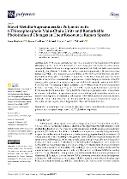Novel Metallo-Supramolecular Polymers with 1-Thioxophosphole Main-Chain Units and Remarkable Photoinduced Changes in Their Resonance Raman Spectra

Publication date
2022Published in
PolymersVolume / Issue
14 (23)ISBN / ISSN
ISSN: 2073-4360Metadata
Show full item recordCollections
This publication has a published version with DOI 10.3390/polym14235207
Abstract
New low-bandgap unimers, with the central thiophene-(1-thioxophosphole)-thiophene (TPT) ring sequence and 2,2':6',2"-terpyridin-4'-yl (tpy) end groups connected to the central unit via conjugated linkers of different size, are prepared and assembled with Zn(II) and Fe(II) ions to metallo-supramolecular polymers (MSPs) that are studied regarding their properties. The most interesting feature of Zn-MSPs is the luminescence extended deep into the NIR region. Fe-MSPs not only show the metal-to-ligand charge transfer (MLCT) manifested by the MLCT band (an expected feature) but also an as-yet-undescribed remarkable phenomenon: specific damping of the bands of the TPT sequence in the resonance Raman spectra taken from solid Fe-MSPs using the excitation to the MLCT band (532 nm). The damping is highly reversible at the low laser power of 0.1 mW but gradually becomes irreversible as the power reaches ca. 5 mW. The revealed phenomenon is not shown by the same Fe-MSPs in solutions, nor by Fe-MSPs containing no phosphole units. A hypothesis is proposed that explains this phenomenon and its dependence on the irradiation intensity as a result of the interplay of three factors: (i) enhancement of the MLCT process by excitation radiation, (ii) the electron-acceptor character of the 1-thioxophosphole ring, and (iii) morphological changes of the lattice and their dependence on the population of new structures in the lattice.
Keywords
coordination polymer, intramolecular charge transfer, iron(II) metallo-supramolecular polymer, metal-to-ligand charge transfer, MLCT, phosphole, terpyridine
Permanent link
https://hdl.handle.net/20.500.14178/1815License
Full text of this result is licensed under: Creative Commons Uveďte původ 4.0 International







